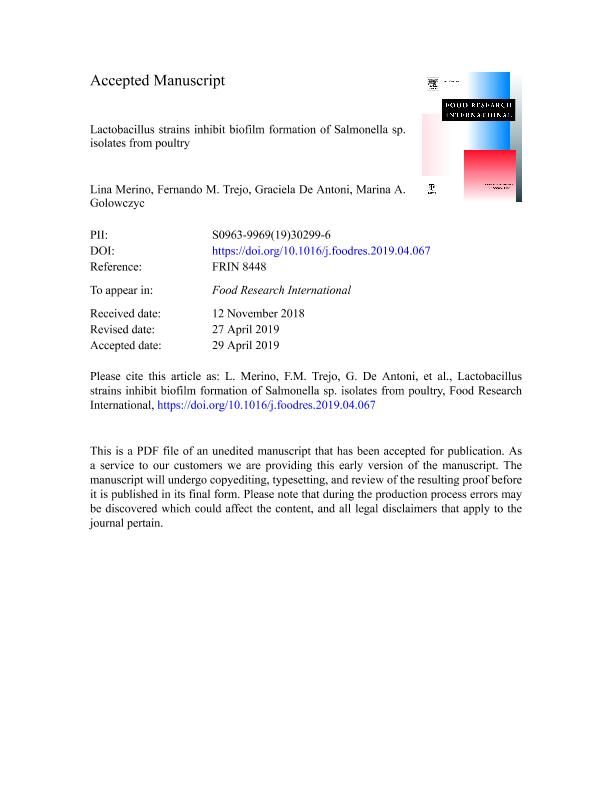Mostrar el registro sencillo del ítem
dc.contributor.author
Merino, Lina Ethel

dc.contributor.author
Trejo, Fernando Miguel

dc.contributor.author
de Antoni, Graciela Liliana

dc.contributor.author
Golowczyc, Marina Alejandra

dc.date.available
2020-05-05T16:19:08Z
dc.date.issued
2019-09
dc.identifier.citation
Merino, Lina Ethel; Trejo, Fernando Miguel; de Antoni, Graciela Liliana; Golowczyc, Marina Alejandra; Lactobacillus strains inhibit biofilm formation of Salmonella sp. isolates from poultry; Elsevier Science; Food Research International; 123; 9-2019; 258-265
dc.identifier.issn
0963-9969
dc.identifier.uri
http://hdl.handle.net/11336/104248
dc.description.abstract
Lactic acid bacteria (LAB)exert a strong antagonistic activity against many microorganisms including food spoilage organisms and may be used as an alternative to control biofilm formation of pathogens in food industries. The objective of this work was to investigate the ability of fifteen Salmonella strains isolated from poultry environment to form biofilms on different surfaces. In addition, the effect of Lactobacillus kefiri strains 8321 and 83113 and Lactobacillus plantarum 83114 and their surface proteins on biofilm development of Salmonella Enteritidis 115 was studied. The relationship between surface properties of bacteria (hydrophobicity, autoaggregation and coaggregation with lactobacilli)and biofilm formation was also investigated. Most of Salmonella strains were hydrophilic and five strains were moderately hydrophobic. In general, Salmonella strains showed high aggregation abilities (27?54%). S. Enteritidis 106 and S. Typhimurium 102 and 108 showed the highest percentages of autoaggregation. All Salmonella strains tested showed aggregation abilities with the three lactobacilli studied, but the percentage of coaggregation proved to be strain-specific. When comparing stainless steel, glass and polystyrene surfaces, higher levels of biofilm formation occurred on polystyrene plate than on glass surfaces or stainless steel. S. Enteritidis 115 exhibited the greatest attachment to polyestyrene surface. The preincubation or coincubation with the three lactobacilli strains significantly reduced (about 1 log CFU/ml of reduction)the ability of S. Enteritidis 115 to form biofilm compared to the control without lactobacilli. These results were confirmed by confocal microscopy. In the same way, when surface proteins extracted from lactobacilli strains were preincubated or coincubated with S. Enteritidis 115, biofilm formation of this strain was significantly decreased compared to the control. The results obtained showed that these Lactobacillus strains and their surface proteins can be used as alternatives for control of biofilm formation by Salmonella in the poultry industry.
dc.format
application/pdf
dc.language.iso
eng
dc.publisher
Elsevier Science

dc.rights
info:eu-repo/semantics/openAccess
dc.rights.uri
https://creativecommons.org/licenses/by-nc-nd/2.5/ar/
dc.subject
AGGREGATION
dc.subject
BIOCONTROL
dc.subject
BIOFILM
dc.subject
SURFACE PROTEINS
dc.subject.classification
Alimentos y Bebidas

dc.subject.classification
Otras Ingenierías y Tecnologías

dc.subject.classification
INGENIERÍAS Y TECNOLOGÍAS

dc.title
Lactobacillus strains inhibit biofilm formation of Salmonella sp. isolates from poultry
dc.type
info:eu-repo/semantics/article
dc.type
info:ar-repo/semantics/artículo
dc.type
info:eu-repo/semantics/publishedVersion
dc.date.updated
2020-04-22T15:54:19Z
dc.journal.volume
123
dc.journal.pagination
258-265
dc.journal.pais
Países Bajos

dc.journal.ciudad
Amsterdam
dc.description.fil
Fil: Merino, Lina Ethel. Provincia de Buenos Aires. Gobernación. Comisión de Investigaciones Científicas. Centro de Investigación y Desarrollo en Criotecnología de Alimentos. Consejo Nacional de Investigaciones Científicas y Técnicas. Centro Científico Tecnológico Conicet - La Plata. Centro de Investigación y Desarrollo en Criotecnología de Alimentos. Universidad Nacional de la Plata. Facultad de Ciencias Exactas. Centro de Investigación y Desarrollo en Criotecnología de Alimentos; Argentina
dc.description.fil
Fil: Trejo, Fernando Miguel. Provincia de Buenos Aires. Gobernación. Comisión de Investigaciones Científicas. Centro de Investigación y Desarrollo en Criotecnología de Alimentos. Consejo Nacional de Investigaciones Científicas y Técnicas. Centro Científico Tecnológico Conicet - La Plata. Centro de Investigación y Desarrollo en Criotecnología de Alimentos. Universidad Nacional de la Plata. Facultad de Ciencias Exactas. Centro de Investigación y Desarrollo en Criotecnología de Alimentos; Argentina
dc.description.fil
Fil: de Antoni, Graciela Liliana. Provincia de Buenos Aires. Gobernación. Comisión de Investigaciones Científicas. Centro de Investigación y Desarrollo en Criotecnología de Alimentos. Consejo Nacional de Investigaciones Científicas y Técnicas. Centro Científico Tecnológico Conicet - La Plata. Centro de Investigación y Desarrollo en Criotecnología de Alimentos. Universidad Nacional de la Plata. Facultad de Ciencias Exactas. Centro de Investigación y Desarrollo en Criotecnología de Alimentos; Argentina. Universidad Nacional de La Plata. Facultad de Ciencias Exactas. Departamento de Ciencias Biológicas. Cátedra de Microbiología General; Argentina
dc.description.fil
Fil: Golowczyc, Marina Alejandra. Provincia de Buenos Aires. Gobernación. Comisión de Investigaciones Científicas. Centro de Investigación y Desarrollo en Criotecnología de Alimentos. Consejo Nacional de Investigaciones Científicas y Técnicas. Centro Científico Tecnológico Conicet - La Plata. Centro de Investigación y Desarrollo en Criotecnología de Alimentos. Universidad Nacional de la Plata. Facultad de Ciencias Exactas. Centro de Investigación y Desarrollo en Criotecnología de Alimentos; Argentina
dc.journal.title
Food Research International

dc.relation.alternativeid
info:eu-repo/semantics/altIdentifier/url/https://www.sciencedirect.com/science/article/abs/pii/S0963996919302996
dc.relation.alternativeid
info:eu-repo/semantics/altIdentifier/doi/http://dx.doi.org/10.1016/j.foodres.2019.04.067
Archivos asociados
